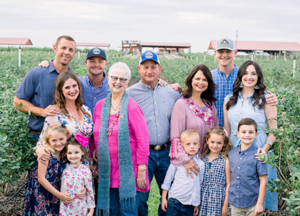As Americans were first being told to practice social distancing and shelter-in-place last month, many farmers were trying to figure out how to reach consumers who used to come to their farms.
During a “normal” year, thousands of buyers showed up at Southern Hill Farms near Clermont, Fla., to pick their own blueberries from early April to the end of May. The family grows about 40 acres of blueberries each year, along with peaches, sweet corn, sunflowers, and zinnias on another 80 acres.
Owner David Hill said that technically, U-Pick operations are allowed to be open for business, but it would have been difficult to safely manage the lines of people who showed up from Tuesday through Sunday. So, the Hill family scrambled to convert from U-Pick to drive-through.
Customers can purchase online and then drive through the farm to pick up their purchases, Hill said.
“It’s only a percentage of the business we would normally do,” Hill says, but they’ve witnessed some spikes in traffic.
He says the Saturday before Easter, the “support your local farmer” concept caught on big.
“We had people pull up in droves” and the wait was sometimes 2.5 hours long, Hill said.
Southern Hill Farms has not had the same crowd since then, but he’s grateful that more people are looking for ways to buy locally and support the farmers who help feed them.
It’s a slightly different story for Community Supported Agriculture (CSA) operations, growing a variety of vegetables, flowers, herbs, berries and more. David Plescia, co-owner of Green Valley Community Farm near Sebastopol, Ca., says their 26-week CSA program for 2020 is already booked full with about 40 more on their waiting list, due to a “huge uptick” of interest as a result of the COVID-19 crisis. Neighboring CSAs are reporting similar surges in demand, he adds.

David and Lisa Hill (center) with other family members, run Southern Hill Farms
Plescia, who farms with his wife Katya, says their operation would not normally sell all of their memberships until June, but this year, they filled up in late March. The couple plans to make some additional adjustments as precautions against COVID-19.
From early June through Thanksgiving, members usually come to the farm and fill a large canvas tote with freshly harvested produce set out in their barn. He says they will harvest with masks and gloves, limit the number of people who can arrive at any one time and likely install a hand-washing station.
Plescia says much of their marketing has been through word of mouth, but this year, there seems to be more active internet searching for local farms and CSAs.
Karin Sinclair, owner of Sinclair Family Farms in Placer County, Ca., has also seen a big uptick in business, mostly from a 50-mile radius. Her family sells beef, lamb and pork and eggs by the carton, flat and case. She sells through a local Farmer Markets as well as monthly deliveries to a variety of select locations
“A lot of people are buying in bulk - a lot of 1/4 beef! Our online store sales have probably gone up 400%,” she says.
But finding local farms is not always easy – especially if you don’t live in the neighborhood and know what to search for.
USDA has a Local Food Directory, which lists thousands of Farmers' Markets, CSAs, Food Hubs and On-Farm Markets. Operators can add or update listings, which will then be approved by the agency and published. Potential customers can then search by zip code to find outlets within 5-200 miles of their location.
In addition, several state departments of agriculture have their own directories.
Each state’s local food directory has a different format. Some websites are broken up by type of food category, others have businesses listed, and some are displayed on an interactive map.
If you go to the Kansas Department of Agriculture’s website and search for “local foods” and “local farms” you will find zero search results. But that’s because KDA has organized a directory for farms and farmers markets under a totally different web site called “From the Land of Kansas.” Unfortunately, the site does not have the word “local” anywhere on the front of the site so it’s hard to find with traditional search terms on Google or other search engines. The site is not listed as a program on the KDA website and it is not listed on USDA’s site.
Marketing Manager Janelle Dobbins says the program was first developed in 1978 by the Kansas Department of Agriculture but was moved in later years to the Department of Commerce and renamed “Simply Kansas” before moving back to KDA with an updated look and trademark. She says discussions are underway to provide the program with more visibility on the KDA site and to make it more accessible.
In addition, Kansas writer and photographer Rick McNary created a Facebook group in late April called “Shop Kansas Farms” that aims to connect people who want to buy from Kansas businesses with those who are selling. In less than 18 hours, he had over 800 members and just a couple of weeks later, he has over 4,400 members.
Missouri’s Food Finder is displayed using an interactive map that showcases different local food businesses around the state, providing contact information, types of food offered, location, type of purchasing options, and a link to the business’ website if applicable. The state’s platform is also set up to allow new registrations of businesses to continue providing access to more local food options.
California’s local food site is first broken down by region, then a county-by-county breakdown of local farms. The directory lists produce that is available or activities families can develop on the farm to offer more agri-tourism options.
Interested in more coverage and insights? Receive a free month of Agri-Pulse or Agri-Pulse West by clicking here.
Tennessee’s local foods website breaks down consumer options based on different sectors of the industry: restaurants/retail, CSAs, Farmers' Markets, Agri-tourism, and produce products available.
“NASDA members are finding unique ways to support local farmers, ranchers, and value-added food producers while strengthening their local economies and communities. From providing guidance to safely keep farmers' markets open, to interactive maps for consumers to find local producers, to online ordering systems, state departments of agriculture are supporting the movement of commodities to consumers who need them the most,” said Barb Glenn, CEO of NASDA.
For your shopping pleasure, Agri-Pulse compiled a list of every state’s local foods directory, click here.
For more news, go to www.Agri-Pulse.com.



